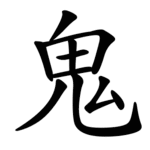Radical 194
Radical 194 (鬼 Unicode U+9B3C, pinyin guǐ meaning "ghost" or "demon") is one of eight Kangxi radicals written with ten strokes.
| 鬼 | ||
|---|---|---|
| ||
| 鬼 (U+9B3C) "ghost, demon" | ||
| Pronunciations | ||
| Pinyin: | guǐ | |
| Bopomofo: | ㄍㄨㄟˇ | |
| Wade–Giles: | kuei3 | |
| Cantonese Yale: | gwai2 | |
| Jyutping: | gwai2 | |
| Japanese Kana: | キ, おに ki, oni | |
| Sino-Korean: | 귀 gwi | |
| Hán-Việt: | quỷ, khuỷu, quẽ, quỉ | |
| Names | ||
| Japanese name(s): | 鬼 oni 鬼繞 kinyō | |
| Hangul: | 귀신 gwisin | |
| Stroke order animation | ||
 | ||
The character is historically composed of 儿 "legs", 田 representing a large demon's head and a curl looking similar to 厶 taken to represent a swirl of vapour, or a demon's tail. The character can be traced to the oracle bone script, where it depicts a man kneeling on a monster head.
Most of the characters derived from the radical have meanings related to ghosts or souls, including 魔 "devil, demon", 魑 "black magic", 魘 "nightmare", 魄 "soul". In some signs, however, the radical is present purely as a phonetic marker, for example in 魏, the State of Wei during the Spring and Autumn period.
Derived characters

seal script character
| Strokes | Characters |
|---|---|
| + 0 | 鬼 |
| + 3 | 鬽 |
| + 4 | 鬾 鬿 魀 魁 魂 |
| + 5 | 魃 魄 魅 魆 |
| + 6 | 魇 |
| + 7 | 魈 魉 |
| + 8 | 魊 魋 魌 魍 魎 魏 |
| +10 | 魐 |
| +11 | 魑 魒 魓 魔 |
| +12 | 魕 魖 |
| +14 | 魗 魘 魙 |
Literature
- Fazzioli, Edoardo. Chinese calligraphy : from pictograph to ideogram : the history of 214 essential Chinese/Japanese characters. calligraphy by Rebecca Hon Ko. New York: Abbeville Press. ISBN 0-89659-774-1.
- Li, Leyi: “Tracing the Roots of Chinese Characters: 500 Cases”. Beijing 1993, ISBN 978-7-5619-0204-2
- Harbaugh, Rick, Chinese Characters: A Genealogy and Dictionary, Yale University Press (1998), ISBN 978-0-9660750-0-7.
- Childs-Johnson, Elizabeth (江伊莉), 甲骨文的“鬼”与假面具 (The Gui-Spirit in Oracle Bone Inscriptions), International Conference Celebrating the 95th Anniversary of the Discovery of Oracle Bone Inscriptions", Anyang, China, 1994.
See also
This article is issued from Wikipedia. The text is licensed under Creative Commons - Attribution - Sharealike. Additional terms may apply for the media files.